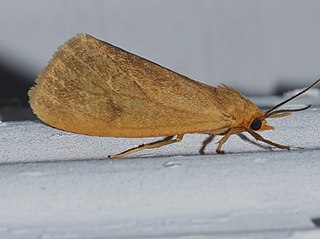
Virbia is a genus of tiger moths in the family Erebidae. The genus was erected by Francis Walker in 1854.

Virbia aurantiaca, the orange holomelina, is a moth species of the family Erebidae found in North America. In the east it has been recorded from Manitoba and Nova Scotia, south along the eastern seaboard to Cordoba in Mexico. It has also been recorded from Texas, Mississippi, Missouri, Tennessee, Louisiana, Oklahoma, Kansas, North Dakota and South Dakota.
Virbia costata is a moth in the family Erebidae. It was described by Richard Harper Stretch in 1884. It is found in the western United States, ranging to western Oklahoma in the east and Colorado in the north.
Virbia elisca is a moth in the family Erebidae. It was described by Harrison Gray Dyar Jr. in 1913. It is found in Peru., French Guiana and Ecuador.
Virbia esula is a moth in the family Erebidae. It was described by Herbert Druce in 1889. It is found in Mexico.
Virbia heros is a moth in the family Erebidae. It was described by Augustus Radcliffe Grote in 1866. It is found on Cuba.
Virbia hypophaea is a moth in the family Erebidae. It was described by George Hampson in 1901. It is found in Costa Rica and Brazil.

Virbia laeta, the joyful holomelina, is a moth in the family Erebidae. It was described by Félix Édouard Guérin-Méneville in 1844. It is found in North America from New Brunswick south to Florida and west to Minnesota and south to Texas. The habitat consists of pine woodlands.
Virbia marginata is a moth in the family Erebidae. It was described by Herbert Druce in 1885. It is found in Mexico, Guatemala, Honduras, New Mexico and Arizona.

Virbia opella, the tawny holomelina, is a moth in the family Erebidae. It was described by Augustus Radcliffe Grote in 1863. It is found in the United States from Maine west to Illinois and south to Texas. The habitat consists of oak forests and scrub oak forests.
Virbia pallicornis is a moth in the family Erebidae. It was described by Augustus Radcliffe Grote in 1867. It is found on Cuba.
Virbia palmeri is a moth in the family Erebidae. It was described by Herbert Druce in 1911. It is found in Colombia.
Virbia rogersi is a moth in the family Erebidae first described by Herbert Druce in 1885. It is found in Costa Rica.
Virbia rosenbergi is a moth in the family Erebidae first described by Walter Rothschild in 1910. It is found in Colombia and Ecuador.
Virbia semirosea is a moth in the family Erebidae first described by Herbert Druce in 1889. It is found in Mexico and on Hispaniola.
Virbia tenuicincta is a moth in the family Erebidae first described by George Hampson in 1901. It is found in Peru.
Virbia xanthopleura is a moth in the family Erebidae first described by George Hampson in 1898. It is found in Grenada.
Virbia zonata is a moth in the family Erebidae first described by Felder and Rogenhofer in 1874. It is found in Mexico.
Virbia porioni is a moth in the family Erebidae first described by Hervé de Toulgoët in 1983. It is found in French Guinea.


